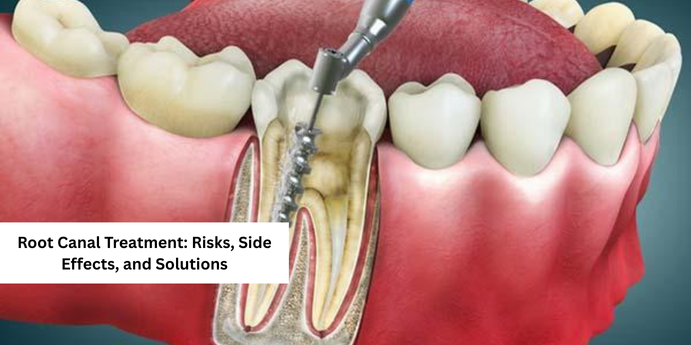
Toothaches can be unbearable, and often they are caused by infections deep inside a tooth. For decades, root canal treatment (RCT) has been the go-to procedure for saving infected or damaged teeth. Despite its reputation as a painful or intimidating dental procedure, root canal therapy has advanced tremendously in terms of comfort and effectiveness.
Still, like any medical or dental treatment, it carries certain risks and potential side effects. Fortunately, most of these can be managed with proper care, expertise, and timely solutions.
At my practice, I often reassure patients that root canal treatment is a safe, effective way to preserve natural teeth and avoid extractions. Understanding the procedure, its possible complications, and the solutions available helps patients make informed choices and overcome anxiety.
What is Root Canal Treatment?
A root canal is a dental procedure designed to remove infection from inside a tooth. The process involves:
- Accessing the pulp chamber – The dentist makes a small opening to reach the infected pulp.
- Cleaning and disinfecting – The infected pulp tissue, bacteria, and debris are removed.
- Shaping the canals – Special instruments prepare the root canals for filling.
- Filling and sealing – The canals are filled with a biocompatible material (usually gutta-percha) and sealed to prevent reinfection.
- Restoration – A crown or filling is placed on the tooth to restore its strength and function.
This procedure allows patients to keep their natural teeth instead of resorting to extraction.
Why Root Canal Treatment is Important
- Saves natural teeth – Preserves the function and aesthetics of your smile.
- Prevents spread of infection – Stops bacteria from spreading to nearby teeth or the jawbone.
- Relieves pain – Provides long-term relief from toothache and sensitivity.
- Restores chewing ability – Strengthens the tooth with a crown or restoration.
Risks and Side Effects of Root Canal Treatment
Although root canal treatment is safe, it is important to be aware of potential risks:
- Post-Treatment Pain and Discomfort
Mild pain, tenderness, or swelling is common for a few days after treatment. This usually subsides with prescribed medications. - Incomplete Removal of Infection
If all infected tissue is not fully removed, the infection may return, requiring retreatment. - Tooth Fracture
A treated tooth can become brittle over time, making it prone to fractures without a crown. - Instrument Breakage
Rarely, dental instruments used during the procedure may break inside the canal. Skilled dentists usually manage this effectively. - Temporary Numbness or Tingling
In lower molars, nerves are close to the tooth roots, and rare cases of temporary numbness or tingling in the lip or tongue may occur. - Allergic Reaction
Although uncommon, some patients may react to the materials used in the procedure.
Solutions and Preventive Measures
- Pain Management
- Over-the-counter painkillers or prescribed medication help control post-procedure discomfort.
- Warm salt-water rinses and avoiding hard foods aid recovery.
- Retreatment and Apicoectomy
- If infection persists, retreatment (redoing the root canal) or an apicoectomy (removing the tip of the root surgically) can resolve the problem.
- Crowning the Tooth
- To protect the treated tooth from fracture, a dental crown is strongly recommended after root canal therapy.
- Modern Equipment and Technology
- Digital imaging, apex locators, and rotary instruments improve accuracy and reduce risks during treatment.
- Choosing an Experienced Dentist
- Expertise is key in minimizing risks. At Saswati Sahu’s Clinic in Kharadi, advanced tools and personalized care ensure safe, successful treatments.
How Patients Can Help Recovery
- Follow post-treatment instructions carefully.
- Take prescribed medications on time.
- Avoid chewing hard foods on the treated tooth until fully restored with a crown.
- Maintain oral hygiene with gentle brushing and flossing.
- Keep up with follow-up visits to ensure proper healing.
Debunking Myths About Root Canal Treatment
- Myth: Root canals are very painful.
Fact: With modern anesthesia and techniques, the procedure is virtually painless. - Myth: Extraction is better than root canal.
Fact: Saving your natural tooth is always preferable; extraction may lead to alignment issues or the need for implants/bridges. - Myth: Root canal treated teeth don’t last long.
Fact: With proper care and a crown, they can last a lifetime.
Safe, Effective, and Smile-Saving
Root canal treatment remains one of the most effective ways to save natural teeth. While there are some risks and side effects, the benefits far outweigh them—especially when the procedure is performed by an experienced dentist using advanced technology.
At Dr. Saswati Sahu – Best Dental Clinic in Kharadi, we ensure root canal procedures are comfortable, precise, and successful, helping patients regain healthy smiles with minimal risk.
Frequently Asked Questions (FAQs)
- How long does a root canal treatment take?
It may take one or two sittings depending on the severity of the infection and the tooth’s complexity. - Is root canal treatment permanent?
Yes. With proper care and a crown, root canal-treated teeth can last a lifetime. - Can infection return after a root canal?
Rarely, yes. Retreatment or apicoectomy can resolve persistent infections. - Is it better to extract a tooth instead of getting a root canal?
No. Preserving your natural tooth is always the best choice, as extractions can cause long-term complications. - How soon can I eat after a root canal?
You can eat once the numbness wears off, but soft foods are recommended until the tooth is crowned.

